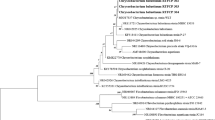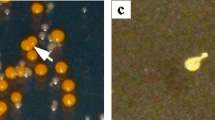Abstract
Urocanic acid, deaminated histidine and the first intermediate in the histidine utilization (Hut) pathway in bacteria, has recently been suggested to have adverse health effects by inducing scombrotoxicosis and immunosuppression after trans–cis isomerization. This work aimed to shed some light on the microbiology of its formation in scombroid fish, given that such information is very scarce. The isolation of urocanic acid producers from chub mackerel was basically based on enrichment of bacteria possessing the Hut pathway with histidine as the sole source of carbon, energy, and nitrogen. Morphological and molecular identification revealed that the isolates (n = 12), taken from the skin, gills, and intestine, were comprised entirely of Acinetobacter from at least five species. This implies that the Hut pathway in the microbes can be particularly active and as such conferred a growth advantage. Dynamic monitoring of bacterial growth and urocanic acid production in fish juice broth indicated that urocanic acid is a primary metabolite and its production is a closely growth-associated process. This in turn implies that its production can be controlled directly by suppressing the bacterial growth. Several potential methods are proposed through a study of the growth characteristics and preservative susceptibility of representative isolates. In conclusion, this work suggests that Acinetobacter can constitute a potentially important group of urocanic acid producers in chub mackerel.




Similar content being viewed by others
References
Zhong JJ, Liao N, He M, Pu Y, Liu D (2018) Development of an analytical method for urocanic acid isomers in fish based on reactive extraction cleanup and chaotropic chromatography techniques. J Chromatogr A 1548:44–50
Ezzat MA, Zare D, Karim R, Ghazali HM (2015) Trans-and cis-urocanic acid, biogenic amine and amino acid contents in ikan pekasam (fermented fish) produced from Javanese carp (Puntius gonionotus) and black tilapia (Oreochromis mossambicus). Food Chem 172:893–899
Hug DH, Dunkerson DD, Hunter JK (1999) The degradation of l-histidine and trans- and cis-urocanic acid by bacteria from skin and the role of bacterial cis-urocanic acid isomerase. J Photochem Photobiol B 50(1):66–73
FAO/WHO (2012) Joint FAO/WHO expert meeting on the public health risks of histamine and other biogenic amines from fish and fishery products. http://www.fao.org/3/a-i3390e.pdf. Accessed 24 May 2018
Hungerford JM (2010) Scombroid poisoning: a review. Toxicon 56(2):231–243
Lehane L, Olley J (2000) Histamine fish poisoning revisited. Int J Food Microbiol 58:1–37
Ullrich SE (2007) Sunlight and skin cancer: lessons from the immune system. Mol Carcinog 46(8):629–633
Zare D, Muhammad K, Bejo MH, Ghazali HM (2015) Determination of trans- and cis-urocanic acid in relation to histamine, putrescine, and cadaverine contents in tuna (Auxis Thazard) at different storage temperatures. J Food Sci 80(2):T479–T483
Anglin JH Jr, Batten WH (1968) Studies on cis urocanic acid. J Investig Dermatol 50(6):463–466
Prater MR, Gogal RM, De Fabo EC, Longstreth J, Holladay SD (2003) Immunotoxic effects of cis-urocanic acid exposure in C57BL/6N and C3H/HeN mice. Photochem Photobiol 77(4):383–389
Zare D, Muhammad K, Bejo MH, Ghazali HM (2015) Determination of urocanic acid, a compound implicated in histamine toxicity, and assessment of biogenic amines relative to urocanic acid content in selected fish and fish products. J Food Compos Anal 37:95–103
Kawai A, Sakaguchi M (1968) Histidine metabolism in fish—II. Formation of urocanic, formiminoglutamic and glutamic acids from histidine in the livers of carp and mackerel. Bull Jpn Soc Sci Fish 34(6):507–511
Sakaguchi M, Kawai A (1968) Histidine metabolism in fish—III. Purification and some properties of histidine deaminase from mackerel muscle. Bull Jpn Soc Sci Fish 34(11):1040–1048
Sakaguchi M, Sugiyama M, Sugiyama T, Kawai A (1970) Histidine metabolism in fish—IV. Comparative study on histidine deaminases from muscle and liver of mackerel and from bacteria. Bull Jpn Soc Sci Fish 36(2):200–206
Mackie IM, Fernandez-Salguéro J (1977) Histidine metabolism in fish. Urocanic acid in mackerel (Scomber scombrus). J Sci Food Agric 28(10):935–940
Baranowski JD (1985) Low-temperature production of urocanic acid by spoilage bacteria isolated from mahimahi (Coryphaena hippurus). Appl Environ Microbiol 50(2):546–547
Shibatani T, Nishimura N, Nabe K, Kakimoto T, Chibata I (1974) Enzymatic production of urocanic acid by Achromobacter liquidum. Appl Microbiol 27(4):688–694
Bender RA (2012) Regulation of the histidine utilization (Hut) system in bacteria. Microbiol Mol Biol Rev 76(3):565–584
Bender DA (2012) Amino acid metabolism, 3rd edn. Wiley, Hoboken
Daniel D, dos Santos VB, Vidal DTR, do Lago CL (2015) Determination of biogenic amines in beer and wine by capillary electrophoresis–tandem mass spectrometry. J Chromatogr A 1416:121–128
Self RL, Wu WH, Marks HS (2011) Simultaneous quantification of eight biogenic amine compounds in tuna by matrix solid-phase dispersion followed by HPLC–orbitrap mass spectrometry. J Agric Food Chem 59(11):5906–5913
Zare D, Muhammad K, Bejo MHB, Ghazali HM (2012) Development and validation of an ion-pair chromatographic method for simultaneous determination of trans- and cis-urocanic acid in fish samples. J Chromatogr A 1256:144–149
Zare D, Muhammad K, Bejo MH, Ghazali HM (2013) Changes in urocanic acid, histamine, putrescine and cadaverine levels in Indian mackerel (Rastrelliger kanagurta) during storage at different temperatures. Food Chem 139(1):320–325
Kumar S, Stecher G, Tamura K (2016) MEGA7: molecular evolutionary genetics analysis version 7.0 for bigger datasets. Mol Biol Evol 33(7):1870–1874
Dalgaard P (1995) Qualitative and quantitative characterization of spoilage bacteria from packed fish. Int J Food Microbiol 26(3):319–333
Parlapani FF, Mallouchos A, Haroutounian SA, Boziaris IS (2017) Volatile organic compounds of microbial and non-microbial origin produced on model fish substrate un-inoculated and inoculated with gilt-head sea bream spoilage bacteria. LWT Food Sci Technol 78:54–62
Serio A, Fusella GC, López CC, Sacchetti G, Paparella A (2014) A survey on bacteria isolated as hydrogen sulfide-producers from marine fish. Food Control 39:111–118
Juni E (2005) Genus II Acinetobacter. In: Garrity GM, Brenner DJ, Krieg NR, Staley JT (eds) Bergey's manual of systematic bacteriology, vol 2 (the proteobacteria), part B (the gammaproteobacteria), 2nd edn. Springer, New York
Kämpfer P (2014) Acinetobacter. In: Batt CA, Tortorello ML (eds) Encyclopedia of food microbiology, vol 1. Academic Press, London
Dunlap CA, Rooney AP (2018) Acinetobacter dijkshoorniae is a later heterotypic synonym of Acinetobacter lactucae. Int J Syst Evol Microbiol 68(1):131–132
Betts G (2006) In: de Blackburn WC (ed) Food spoilage microorganisms. Woodhead Publishing, Cambridge
Saha SC, Chopade BA (2002) Effect of food preservatives on Acinetobacter genospecies isolated from meat. J Food Sci Technol 39(1):26–32
Teixeira LM, Merquior VLC (2014) The family Moraxellaceae. In: Rosenberg E, DeLong EF, Lory S, Stackebrandt E, Thompson F (eds) The prokaryotes: gammaproteobacteria, 4th edn. Springer, Heidelberg
Gram L, Dalgaard P (2002) Fish spoilage bacteria—problems and solutions. Curr Opin Biotechnol 13(3):262–266
Imanaka H (1962) Urocanic acid production by sporogenous bacteria: Part II. Cultural conditions and mechanisms of urocanic acid accumulation. Agric Biol Chem 26(1):49–55
Lambert AD, Smith JP, Dodds KL (1991) Shelf life extension and microbiological safety of fresh meat—a review. Food Microbiol 8(4):267–297
Weng PF, Li WW, Wu ZF, Zhou XJ, Chen SB, Zhang JJ (2013) Analysis of bacteria diversity and predominant microorganism in aquatic products of mackerel. Oceanol Limnol Sin 44(3):788–795
Dalgaard P (2014) Microbiological changes. In: Ryder J, Iddya K, Ababouch L (eds) Assessment and management of seafood safety and quality: current practices and emerging issues. FAO, Rome
Kowalski W (2010) Ultraviolet germicidal irradiation handbook: UVGI for air and surface disinfection. Springer, Heidelberg
Sanjuás-Rey M, Gallardo JM, Barros-Velázquez J, Aubourg SP (2012) Microbial activity inhibition in chilled mackerel (Scomber scombrus) by employment of an organic acid-icing system. J Food Sci 77(5):M264–M269
Metin S, Erkan N, Varlik C, Aran N (2001) Extension of shelf-life of chub mackerel (Scomber japonicus Houttuyn 1780) treated with lactic acid. Eur Food Res Technol 213(3):174–177
Mah JH, Hwang HJ (2009) Effects of food additives on biogenic amine formation in Myeolchi-jeot, a salted and fermented anchovy (Engraulis japonicus). Food Chem 114(1):168–173
Peterkofsky A, Mehler LN (1963) Inhibition of pseudomonas histidase: evidence for a metal cofactor. Biochim Biophys Acta (BBA) Spec Sect Enzymol Subj 73(1):159–162
Silva CC, da Ponte DJ, Dapkevicius MLE (1998) Storage temperature effect on histamine formation in big eye tuna and skipjack. J Food Sci 63(4):644–647
Acknowledgements
This work was supported by the National Key Research and Development Program of China (Grant number 2016YFD0400301) and the National Natural Science Foundation of China (Grant number 31701715). The authors are indebted to Patrick Leung for English proofreading.
Author information
Authors and Affiliations
Corresponding author
Ethics declarations
Conflict of interest
The authors declare that they have no conflict of interest.
Compliance with ethics requirements
This article does not contain any studies with human or animal subjects.
Additional information
Publisher’s Note
Springer Nature remains neutral with regard to jurisdictional claims in published maps and institutional affiliations.
Rights and permissions
About this article
Cite this article
Zhong, JJ., Liao, N., Li, C. et al. Acinetobacter as a potentially important producer of urocanic acid in chub mackerel, a histidine metabolite of emerging health concern. Eur Food Res Technol 245, 825–835 (2019). https://doi.org/10.1007/s00217-018-3217-y
Received:
Revised:
Accepted:
Published:
Issue Date:
DOI: https://doi.org/10.1007/s00217-018-3217-y




